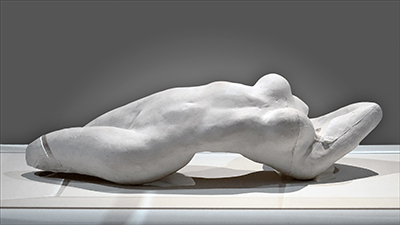This sculpture from Auguste Rodin is loosely dated at around 1878-1884. It features the model, Adèle Abbruzzesi, who was one of the artist's favourite choices for his live figure pieces. The initial work was in plaster, before being completed in terracotta.
Rodin loved to use live models as inspiration for his sculptures and he would often also complete drawings and paintings of them in order to make notes for future reference. In some cases he may re-use models for days on end before finding the right idea for his work and he would then meticulously amend his sculptures over a long period before arriving at the completed piece. He would also change his titles many times and preferred to leave a name until after the work was completed, which he felt allowed him more freedom to work as he wished. In this case perhaps he found it much more easy than normal, as he simply refers to what he depicted, which is the torso of his model, Adèle Abbruzzesi. She is known to have an admirable body, slim and toned like a dancer and this seems to have suited Rodin's sculptural style. He also put great emotion into his work and felt that his best ones were akin to living beings.
This sculpture was eventually used in the Gates of Hell, though added after many of the other elements. Initially it was without legs before they were added as late as 1889. There are also similarities between this torso and elements from two other sculptures, namely Eternal Springtime and also Illusions Received by the Earth. Documentation mentioning the original piece have suggested that the Torso of Adele was originally a study piece which Rodin then decided to develop onwards as he started to appreciate the direction of this work. He felt that this model could help him deliver truly sensual sculptures and so he happily re-used her services many times. These sculptures may have strengthened the bond between the two as well as he sometimes blurred the lines between sculpture and human life.
Rodin was someone whose appearance was of a huge, imposing man but he actually held an incredibly delicate touch when it came to understand and depicting the female body. He managed to recreate the beautiful features of this young woman to a level of near perfection. Some would even question his working methods sometimes, because of the level of accuracy that he produced. In reality, it was a combination of hard work, natural flair and also a deep thinking mind that seemed able to connect with his model's emotions as well as the very subtle variations in their physical structures.




